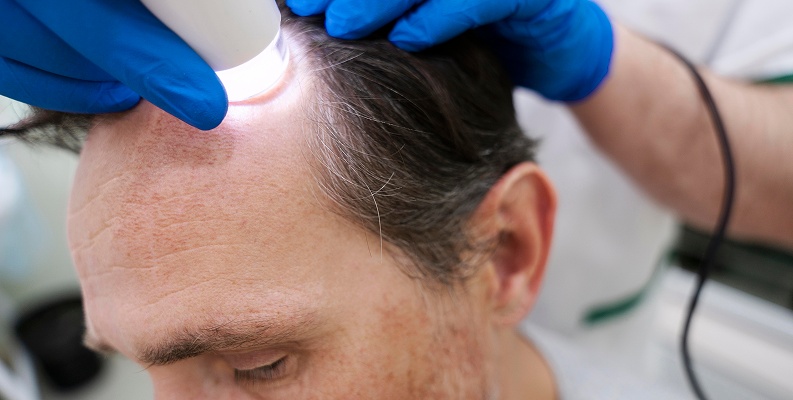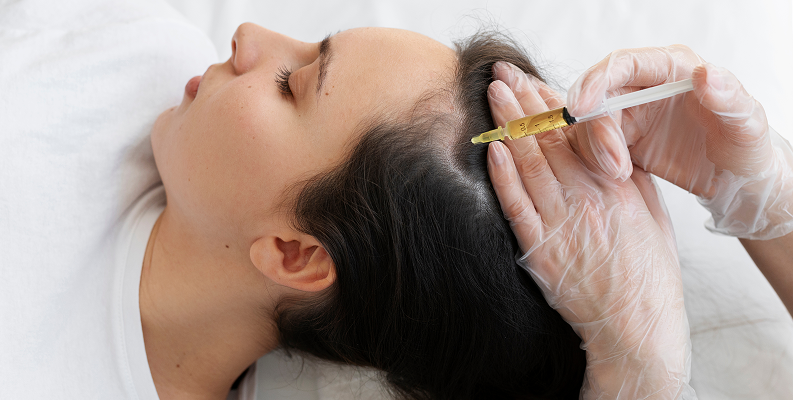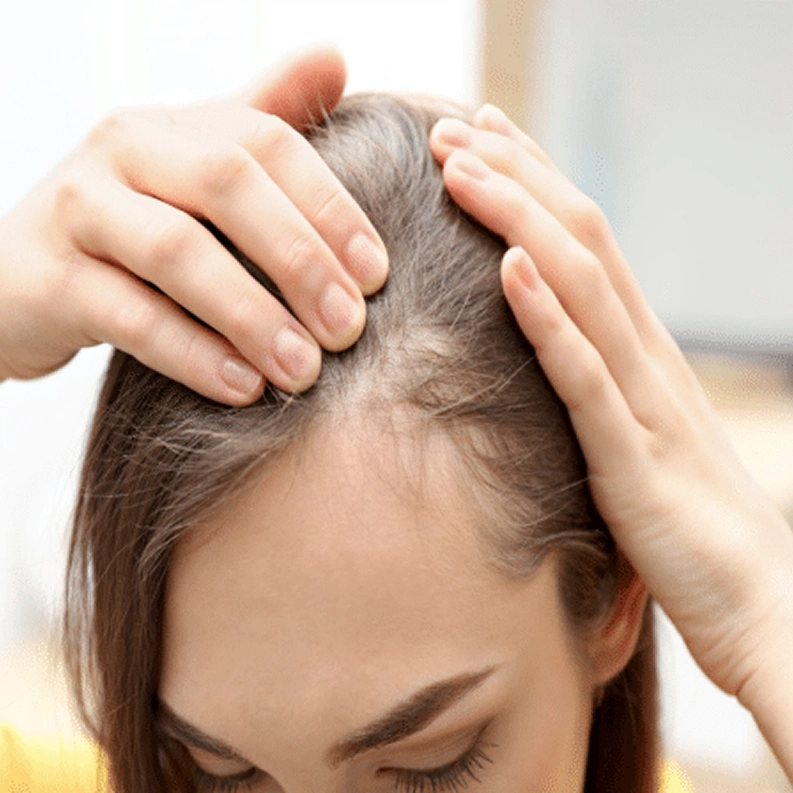Hair loss is a common concern that affects both men and women, leading many individuals to seek effective hair restoration options. While hair transplant surgery has traditionally been the go-to treatment, Palm Beach Health Works offers stem cell therapy as a promising alternative for those looking to restore their hair. Stem cell treatment provides a non-invasive, regenerative approach that may promote hair regrowth and rejuvenate hair follicles. With advancements in stem cell hair therapy, patients now have more choices for treating hair loss and encouraging natural hair growth.
Stem Cell Therapy
Stem cell therapy is a revolutionary treatment that harnesses the regenerative power of stem cells to promote healing and tissue regeneration. In the context of hair restoration, stem cell therapy focuses on stimulating hair follicles to regenerate hair growth, making it a promising option for those struggling with hair loss.
Stem cell therapy involves using specialized cells known as stem cells, which can develop into various types of cells and tissues. When applied to the scalp, these cells can stimulate hair follicles, encouraging hair regrowth and improving hair health.

Medical Applications of Stem Cells
Stem cells are widely used in regenerative medicine to treat a variety of conditions. From aiding in tissue repair to treating chronic diseases, stem cell treatments have shown great promise in healing damaged tissues.
Benefits for Hair Loss
Stem cell therapy is becoming a popular alternative for hair restoration. This treatment offers several benefits over traditional hair transplant procedures:
- Rejuvenates Hair Follicles: Stem cells can reactivate dormant hair follicles, encouraging them to produce healthy, stronger hair.
- Promotes Hair Regeneration: Stem cells stimulate the growth of new hair by enhancing hair growth at the cellular level.
- Increases Hair Density: By rejuvenating multiple hair follicles, stem cell therapy can result in thicker, fuller hair.
- Non-invasive: Unlike hair transplant surgery, stem cell treatments are non-invasive, requiring no cuts or stitches, with minimal recovery time.
How Stem Cell Therapy Works for Hair Loss
Stem cells are applied to the scalp to stimulate hair follicles and promote the hair growth cycle:
- Activation of Hair Follicles: Stem cells help follicles enter the anagen (growth) phase of the hair cycle, encouraging hair regrowth.
- Improvement in Hair Density: As follicles reactivate, hair density increases, leading to fuller, thicker hair over time.
- Long-term Results: With consistent treatment, stem cells continue to support hair regeneration, helping maintain natural, healthy hair growth.
How Stem Cells Work
Stem cells are regenerative cells that can transform into different types of cells and tissues. Their ability to promote healing and tissue repair makes them valuable in medical treatments, including stem cell therapy for hair restoration. When applied to the scalp, stem cells rejuvenate hair follicles, stimulate hair regrowth, and support hair regeneration, offering a highly effective solution for hair loss.
Stem cells are undifferentiated cells with the potential to become specialized cell types. They are crucial for tissue regeneration and repair, which is why they are used in treatments like stem cell hair therapy. These cells help repair damaged tissues and support growth in areas such as the scalp.
Types of Stem Cells
There are several types of stem cells, each with different regenerative capacities:
- Embryonic Stem Cells: These stem cells are pluripotent, meaning they can differentiate into any type of cell in the body. Although their use in therapy is limited, they have the potential to be highly beneficial in regenerative medicine.
- Adult Stem Cells: These stem cells are found in various tissues, including the scalp, and are responsible for maintaining and repairing the tissue in which they are located. For hair restoration, adult stem cells derived from hair follicles are most commonly used to regenerate hair growth and rejuvenate the scalp.
- Induced Pluripotent Stem Cells (iPSCs): These are adult stem cells that have been reprogrammed to behave like embryonic stem cells. They offer the potential to create versatile cells that could be used in cell therapy for hair loss treatment.
Role of Stem Cells in Tissue Repair and Regeneration
Stem cells play a pivotal role in tissue repair and regeneration by replacing damaged or aged cells with new, healthy ones. When applied to the scalp, stem cell treatment stimulates the rejuvenation of hair follicles, promoting the growth of new hair and improving the overall condition of the scalp. Stem cells can repair damaged hair follicles, leading to hair regrowth and hair regeneration. This regenerative ability makes stem cells a key component in advanced hair restoration therapies, including stem cell hair therapy.
Stem Cells for Hair Growth
Stem cells are key to hair regeneration and hair growth by initiating the hair growth cycle and renewing and maintaining the health of the follicles. They can regenerate tissue in hair follicles, allowing continuous hair production.. Once stimulated, they divide and differentiate into cells that support hair growth and the formation of new hair strands.
Stem cells are a highly specialized technique for hair regeneration. They can renew and maintain the hair follicle’s structure, making them a powerful tool for hair regrowth.

Role of Stem Cells in the Hair Growth Cycle
The hair growth cycle consists of three phases: anagen (growth), catagen (transitional), and telogen (resting). Stem cells are primarily active during the anagen phase, where they support the production of new hair strands. When hair follicles are damaged or enter a dormant state due to hair loss,the follicles can be reactivated through stem cell treatment or exosome therapy, promoting the regeneration of healthy hair follicles and initiating the growth of new hair.
How Researchers Use Stem Cells to Stimulate New Hair Growth
Researchers are exploring several ways to harness the potential of stem cells for hair regrowth. Techniques such as stem cell hair therapy involve isolating and cultivating hair follicle stem cells in the lab, before reintroducing them to the scalp to regenerate hair follicles and stimulate new hair growth. Other methods include injecting stem cells or exosomes, which contain regenerative factors like growth proteins and micro RNA, into the scalp to support hair restoration and accelerate the healing of damaged tissues.
Hair Growth
Hair growth follows a complex cycle involving multiple stages, each playing a crucial role in the development of healthy, strong hair. Stem cell therapy has emerged as a promising approach to stimulate and enhance the natural hair growth cycle, offering a non-invasive option for those experiencing hair loss or seeking hair restoration. By targeting the underlying cells in hair follicles, stem cell treatments can promote hair regeneration, support hair growth, and help restore fuller, thicker hair.
The Stages of the Hair Growth Cycle
- Anagen Phase (Growth Phase): This is the active phase of hair growth, where hair follicles rapidly produce new hair cells. This phase can last from 2 to 6 years, with hair growing at an average rate of about 1 centimeter per month.
- Catagen Phase (Transitional Phase): In this short phase (2-3 weeks), the hair follicle shrinks, and the hair stops growing. The hair strand detaches from the follicle but remains in place.
- Telogen Phase (Resting Phase): This is the resting phase, which typically lasts 3-4 months. After this, the old hair sheds and new hair begins to grow in its place.
Stem cells are primarily active during the anagen phase, where they help in the formation of new hair follicles and the continuation of hair growth.
How Stem Cell Therapy Can Stimulate the Hair Growth Cycle
Stem cell therapy works by rejuvenating the hair follicles, particularly in the early stages of hair loss. By introducing stem cells into the scalp, the treatment activates dormant or weak hair follicles, triggering the transition from the telogen phase to the anagen phase. This stimulation helps the follicles produce stronger, healthier hair, leading to improved hair regrowth. Additionally, stem cell hair therapy can promote the formation of new blood vessels in the scalp, ensuring better oxygen and nutrient delivery to the hair follicles, which is essential for healthy hair regeneration.
Cell Therapy for Hair Restoration
This can involve the use of exosomes, growth factors, and stem cells derived from dermal fibroblasts to provide regenerative components that encourage hair growth and follicle health.
Success Rates and Current Research on Stem Cell Therapy for Hair Loss
Studies on stem cell therapy for hair loss have shown promising results, especially for individuals who are in the early stages of hair loss. Research has demonstrated that stem cells can reactivate dormant hair follicles, leading to hair regrowth and improvement in hair density. Clinical trials indicate that stem cell treatments may be particularly effective in patients who are not yet candidates for hair transplant surgery or those who have mild to moderate hair loss.
Promising Results
Research continues to explore the effectiveness of combining stem cells with other regenerative treatments, such as exosome therapy, to enhance hair restoration results.
- Potential Long-Term Benefits of Using Stem Cells for Hair Restoration: One of the key advantages of stem cell therapy is its potential for long-term results. Unlike traditional hair treatments, which may require ongoing maintenance, stem cell treatments can have a lasting impact by stimulating the body’s natural hair regeneration processes. Over time, stem cell hair therapy has the potential to not only restore hair growth but also improve the overall health and strength of hair, offering a sustainable solution for hair restoration.
- Improved Hair Quality: As stem cells promote the regeneration of healthy hair follicles, patients may notice thicker, fuller hair with improved texture and volume.
- Reduced Need for Frequent Treatments: Once the hair growth process is stimulated and hair follicles are rejuvenated, patients may not need to undergo as many treatments, resulting in long-term cost savings and convenience.
Stem cell therapy offers a promising solution for hair loss, stimulating hair regrowth and promoting hair regeneration by reactivating dormant hair follicles. At Palm Beach Health Works, treatments like stem cell hair therapy and cell therapy for hair have shown encouraging results, particularly in the early stages of hair thinning. Continued research in this field, including the use of exosomes and other regenerative components, is expected to enhance the effectiveness of hair restoration treatments. Individuals need to consult with a qualified professional to determine the best treatment plan for their specific needs, ensuring optimal results in hair growth and hair restoration.




